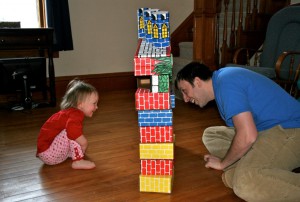Building blocks. Do they bring back childhood memories of terrorizing your home? Yeah—the ones you used to throw at your sister. Or try to put in the toilet or in the dog’s mouth. Or that you’d build up and knock over creating a spectacular mess.
You might almost find it’s hard to believe how much you were learning while causing all that chaos.
But, blocks are seen as such a valuable learning tool, that the entire March issue of Young Children (The Journal of the National Association for the Education of Young Children) is dedicated to blocks.
I suppose I’m not hugely surprised by this, after we spent a bunch of time in an Infant Developmental Play class talking about blocks. Researchers have shown playing with blocks develops motor skills, classification ability, imagination (Hirsch 1996), social skills, language, early reading ability (Hanline, Milton, & Phelps 2010) and math skills (Petersen & Levine, 2014). So, here are some ideas for more ways you can help your child to learn with blocks, by applying some of the same techniques that teachers in infant classrooms use.
3-8 months
In an Infant Developmental Play class, with my daughter, we observed what happened when the instructor built a stack of blocks in front of a 6-month-old. The infant slowly grabbed one from the middle and put it in her mouth. He seemed content. Then the instructor showed the baby how to click two blocks together. Next, she showed him how to know the tower of blocks down. She then rebuilt the stack and the baby knocked it down then started clicking two blocks together. Voila, new skills (and a lesson in cause and effect).
You can also try partially or completely covering a block with a receiving blanket, to see if the child looks for it when it’s covered. You can make it a game, by suddenly yanking the blanket off of it and making funny sounds. This helps to teach object permanence, meaning that an object continues to exist even when it’s out-of-sight.
Your infant may enjoy (and learn from) handling, mouthing, banging and shaking blocks. The findings of one study (Guyton, 2011) encourage sensory motor play by selecting blocks with different weights, textures, colors, sizes and materials, including things like shoeboxes and cups. You can also incorporate blocks with tummy time, for example, by giving your baby a few options to explore, like a smooth cylindrical wooden block, a fabric square block with a bell inside, and a bumpy plastic triangular block. Of course, for this age, it’s important to choose blocks that are safe for mouthing—a good guideline is that they should be too large to fit through a roll of toilet paper.
8-18 months
Older infants shift to volumetric block play, like dumping out a tub of blocks and placing blocks in holes. Infant learn by experimenting with how many blocks they can carry and whether they can carry them in their mouths (Miller, 1999). Likewise, they can practice balance while walking with blocks (Hirsch 1996). You may see brief interest in building short block stacks, with more interest in driving plastic cars around or playing with fake animals.
An important role of a facilitator at this age to set out enough toys to play with, but not so many that a child gets overwhelmed by the clutter. Then you can rotate blocks.
Looking for more ideas that will keep your child interested and learning? Try soft blocks for knocking down, large foam blocks for carrying, mirrored blocks, different sized containers, a muffin tin, or fabric scraps (for hiding blocks, cars, etc).
18-24 months
If multiple kids play in the same area, try to have lots of types of blocks for children to play with at the same time. You can encourage dramatic and imaginative play by including people and animal figures, toy vehicles, fake plants, and bits of fabric (for creative purposes like blankets for the plastic people). You can also use ramps and tubes to encourage scientific play.
Around this age, children may transition from independent play to observing another child’s idea and trying it themselves (e.g.: building a road and placing a car on it). Also, groups of toddlers will look to build together, creating communal towers and structures. When this happens, it’s a signal to add more props and accessories.
It’s a good idea for facilitators to try to rotate toys out, if a child is getting bored. But you can keep some toys in play, if another child isn’t done yet. You may end up with one kid’s firetruck at another kids’ imaginary zoo. And, that’s OK.
You can also coach children to play nicely together. If a child seems crowded, you can suggest building where there is more space and offer to help move materials. Or, if one child wants to build and the other wants to knock over that tower, you can discuss the problem, the children’s emotions and possible solutions. Examples of possible solutions are building a separate “knocking down” tower or taking turns.
Last, facilitators can narrate what’s going on and ask open-ended questions, to help children develop language and reasoning. For example, you can ask, “what will happen if you put that block on top?” or “which row is bigger?” Likewise, by moving blocks from one stack or pile to another, one-at-a-time, you’re demonstrating basic addition and subtraction.
So, yeah, you may have a mess in your future and a bit of conflict resolution (please, don’t knock over your sister’s tower). But, it’s worth it. Blocks are lots of fun and they teach so much. Hopefully these tips will help you keep the chaos manageable and will keep your little one learning and playing.
_ _ _
If you enjoyed this article and want to see more from Mama Lovejoy, you can automatically receive articles in your Facebook newsfeed by “liking” the Mama Lovejoy Facebook page.

Who would have thought???? Love it!